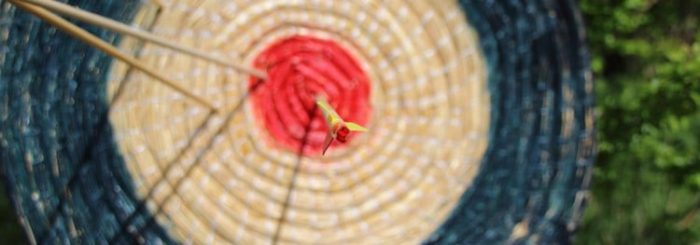There are a lot of simple accessories that are designed to help you achieve a better aim. If you’re struggling with keeping a consistent anchor when shooting your bow, this one will be great for you. So what is a peep sight on in archery?
A peep sight is a small circular aiming aid, mounted on the string of your bow. It’s designed to help you achieve a more consistent anchor point and better grouping through that. You use it similarly to a rifle peep sight, by aligning the pins on both sights with the target.
Many archers claim that using a peep sight helped them with achieving much better accuracy because it helped them with consistency. Others say it didn’t help them at all, and just added a redundant step to their shooting process. If you’re considering getting a peep sight on your bow – this is just the place, so read along.
Note: Some of the links on this page are affiliate links. This means that if you buy through one of them, I’ll earn a small commission, at no additional cost to you. It’s a great way to support the website.
How does a bow peep sight work?
Just like with a rifle peep sight, a bow peep sight works by having two reference points for you to line up your sight with the bow. Basically, you install the peep sight so when both your sights are lined up, you view the target parallel to the direction the arrow is facing. It’s just an aid that lets you know you’re in the correct anchor point.
Simply put, there a 3 points you have to line up: the peep sight, the bow sight, and the target. Once they’re all lined up, you’re aiming directly at the target.
To aim with a peep sight, all you need to do is draw the bow and align the position of your sights. Basically, the circles that make your peep sight and standard sight should perfectly align.
An optimal peep location is essential for good accuracy. Any misplacement in the peep height can completely ruin your grouping, so make sure that it’s in a location that feels natural to you. A good test for the sight location is to draw your bow with your eyes closed, anchor, and open your eyes and see if the peep sight is centered. If it isn’t located exactly in front of your eye, it should be adjusted.
I’ve found this video that details peep sight and how to use them, and I think it’s worth watching.
Peep sights can increase your accuracy, especially if you have trouble with consistent anchoring. Having the added reference point will definitely increase your consistency, and eventually your grouping as well.
Do you need a peep sight on your bow?
Many new archers wonder if they should get a peep sight on their bows. The real answer is – it depends. A peep sight will increase your consistency and will eliminate distractions by limiting your field of vision, but it will limit your ability to see in low light environments and make you dependant on it for shooting.
The main reason you might want to add a peep sight to your bow setup is consistency. It’s obviously not a cure-all solution, but many archers say that using a peep sight helped them with anchoring, which in turn increased their accuracy and consistency.
Another reason for using one is that it helps by eliminating outside distractions. The peep sight somewhat limits your field of vision, which can help with focusing on the target and not noticing other things. This can be helpful, for example, in competitions, where you might be distracted by other people.
But peep sights don’t come just with pros. Since they limit the vision and the amount of light that goes into your eyes, shooting in low light environments is harder with peep sights. The smaller the sight diameter is, the worse it is in low light. This mainly affects bowhunters, that need to have the best vision the can of the target. Some brands try to solve this issue by offering an illuminated sight, but it’s not the same as not using one at all.
Another issue most people seen to forget is that once you’re using a peep sight, you’re pretty much dependant on it. It will be harder to start learning to anchor without a peep. If your peep is somehow damaged, or you’re forced to shoot a bow without a peep for some reason, your accuracy will be much worse.
Knowing this, you’ll be able to make an informed decision of whether or not you need a peep sight on your bow. But let say you decide to use one… How do you choose a peep sight that will fit your needs?
How to choose a peep sight?
Peep style
So the first thing you should consider is whether you should get a tube peep or a tubeless one. Tube peeps recommended if you have a low-quality bowstring, but nowadays they’re rarer because the strings are mostly better and more stable.
A tube peep has a rubber or silicone material that, once the bowstring is pulled, pulls and rotates the peep into the correct position. It’s mainly added because lower quality string tends to rotate. Since bowstrings are generally better now, and because the tubings generally become dry and break over time, most peep sights are tubeless. You can still get a tube peep though, and if you decide to do that – I’d go with a silicone one. They tend to last longer.
A tubeless peep is simply free-floating on the string. Since the bowstring doesn’t rotate as much these days, they are simply put in the center of the string. If you have a standard bow, you should probably go with a tubeless peep.
Size
Another thing you should consider is the peep size. They are usually measured in fractions of inches. They range between 1/32″ and 1/4″, but the most common sizes are 1/4″, 3/16″ and 1/8″.
Generally, smaller peep sights are more accurate and are typically preferred by target archers. Larger peeps are better for low light shooting and limit your vision less than smaller ones. They are typically chosen by bowhunters. So if you’re a target archer you should probably go for a 1/8″ peep, and if you’re a bowhunter go for 1/4″.
Number of slots
It’s nothing to freak out about, but another small thing to consider is the number of slots on your peep sight. These are simply the strings that are used to attach your sight to the bowstring. There are two-slots and three-slots peep sights.
Three slots are considered to be a bit less fussy but are somewhat harder to install. Most archers choose to go with the simpler two-slots peep sights.
What is the best peep sight for a compound bow?
My be recommendation would be to go with the TRUGLO Versa (link to Amazon). It’s a really affordable 1/4″ tube peep, that is actually adjustable to different sizes. If you’re not sure about what sizes to go for, or you’re both into target archery and bowhunting, this one will be a great fit for you.
If you’re still conflicted about which peep sight to get, I’d suggest going to your local archery shop. Installing a peep sight is a hard task anyway, so you might just purchase the peep directly from the shop and hire them to install it. They’ll probably have good recommendations that will fit your needs.
How do you put a peep sight on a bow?
Installing your peep sight is not an easy task. Once you’ve marked the desired position, you need to place your bow on a bow press, separate the strands of the bowstring and place your peep between them. Once you’ve checked everything is in place, tie it up.
Like I’ve stressed before, the placement of your peep sight is crucial. The first thing you’re going to do is mark down the location you’re going to install the peep in. To do that, pull back your bow and with the help of a friend mark the proper location. It should be right in front of your eye level. You can use a small sticker or a pen to mark the location.
When you have that done, it’s time to install the peep. To do that, you’ll need to put your bow on a bow press and separate the strands of the string. Make sure you’ve done that properly and make sure all string fibers are in place. Locate the center of your bowstring in the correct position and install the peep.
Now take your bow off the bow press, and check the location and orientation of the peep. To do that, try pulling your bow with your eyes closed, anchor and then open them. If you’ve ended up too high or too low, you’ll have to put the bow back on the press and adjust the location.
Once your peep is in the correct location and orientation, you can tie it up. You do that by installing stop knots above and below the peep sight. This will still be done on the bow press, with a small amount of tension taken off the bow. You should have enough tension to keep the peep in place, but no so much that it’s hard to tie the knots close to the peep.
Make sure that you don’t tie the peep itself to the string, because you’ll have to cut the tying string off every time you want to adjust the sight. With the ties above and below the peep, you can adjust it by simply pressing it and realigning it.
If this seems too hard or complicated, I’d suggest going to your local archery shop and have a professional put the peep sight on your bow. This way you’ll be sure everything is in place.
Conclusions
Peep sight can be an incredible tool for improving the consistency of your anchoring. They can improve your accuracy, and make shooting easier, but they do make it harder to perform in a low-light environment.
Overall using a peep sight is pretty easy and can help you. If you feel like you’re going to benefit from using one, I’d urge you to choose one that fits your needs. I hope you’ve learned something new in this post, so thanks for sticking around.



